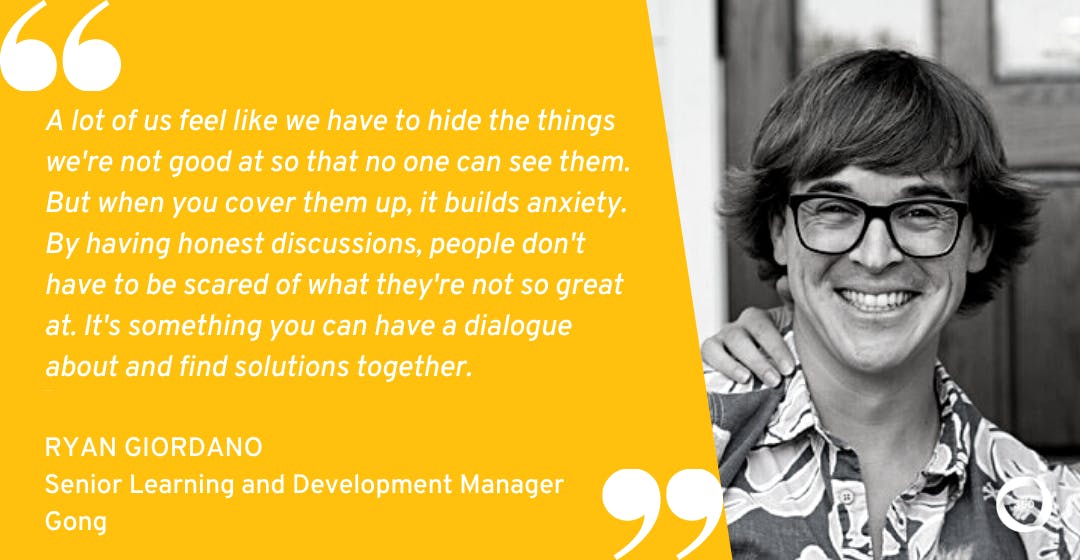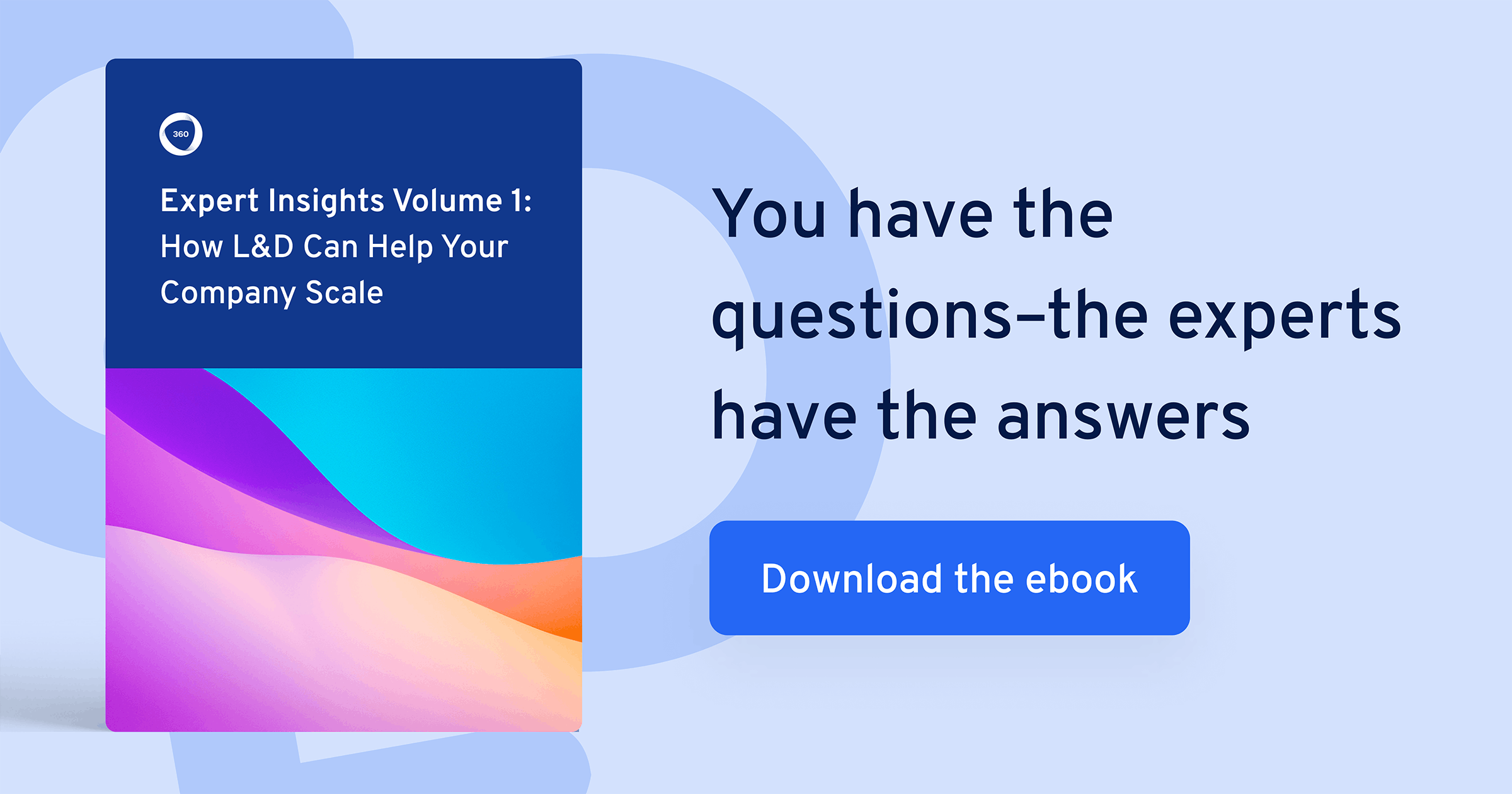
How Gong Built a Performance Management Approach to Attract, Motivate, and Reward Ambitious People
Revenue intelligence platform Gong is one of the fastest-growing startups out there–and one of the most exciting companies to watch. In mid-2020, their $200 million series D fundraising pushed the company into unicorn status, with an overall valuation of $2.2 billion.
With big fundraising and fast growth comes equally big expectations for employee performance. Right now, Gong needs the best talent in the market to support its meteoric rise, which makes employee performance management more important than ever.
Recently, I had the chance to chat to Ryan Giordano, Senior Learning and Development Manager at Gong, about how he’s rising to this challenge with a performance management approach that attracts, motivates, and rewards ambitious people.
We kicked things off by discussing Ryan’s efforts to put a friendly face on performance management.
Putting a friendly face on performance management
According to Ryan, one of the biggest challenges at Gong has been finding a new way to make performance management less scary.
“I joined Gong about six months ago,” he says. “One of the first areas I started looking into was performance management. That’s a term that’s intimidating and scary for many people, so in recent years it’s been recast as something a little lighter and friendlier.”
“At its core, performance management is about one question: are you and your manager well-aligned, well-informed, and communicating well about how you’re performing?”
As Ryan explains, this focus on communication is critical to effective leadership. “You want to know that if you need to drive a certain initiative, or if you’re trying to get your whole team moving in the same direction, you need to be able to communicate clearly and tell someone whether they are or aren’t meeting expectations.”
“It’s purely for their own benefit, because they need to figure out what they need to do, and what ways they need to grow, so that they can continue to contribute at the level they want to.”
Another big challenge at Gong? Making room for ambitious people.
Related: Your New Manager Training Isn’t Working—Here Are 4 Ways to Revive It
At its core, performance management is about one question: are you and your manager well-aligned, well-informed, and communicating well about how you’re performing?
Need a few more CLO Connect expert insights? Find out How L&D Can Help Your Company Scale
How Gong makes room for ambitious people
For Ryan, having a clear and impactful performance management approach is crucial for Gong to attract, motivate, and reward ambitious people.
“A lot of companies hire really ambitious people, and they come in and expect to be promoted once or twice a year, because they want to work that hard and achieve that much,” says Ryan. “The challenge is, when you have a smaller company, sometimes the infrastructure isn’t set up to help people understand where to go next in their careers.”
“Performance management exists to help guide really ambitious folks and give them a sense of what they could do next, while also helping leadership and managers drive teams in the same direction and help people all together.”
So, what does this look like at Gong? “We have a lot of ambitious employees, and we have managers looking to drive new business initiatives. At a really lofty level, we seek to be the type of company where people are getting more out of their time with us.”
According to Ryan, not every company adopts this philosophy. “In some parts of the tech sector, people are still just in it for the paycheck. But we want people to feel like they’re really growing, because that makes your time at our company feel more valuable.”
“Whether it’s overcoming a challenge like public speaking or learning new skills like market segmentation, ultimately we want to build performance management practices that help people focus on their goals and drive authentic conversations with their managers.”
For Ryan, this is all about creating the right performance management ecosystem.
In some parts of the tech sector, people are still just in it for the paycheck. But we want people to feel like they’re really growing, because that makes your time at our company feel more valuable.
Creating a decentralized performance management ecosystem
“The role of L&D is to establish an ecosystem,” says Ryan. “A lot of folks in L&D come from somewhere else, with a background in training or enablement. They’re used to asking, ‘what’s the situation? What do people need to learn, and how do we get them there?’ But when you get to a certain scale, that doesn’t work.”
“In our case, when you’re trying to get a company of 400+ people to have conversations about performance development, you can’t afford to go and train people one at a time. Instead, you need to take a more holistic approach.”
In practice, this ecosystem at Gong consists of a decentralized approach focused on resources, planning, and communication.
“Instead of prescribing one-on-one training, you need to make sure you set people up with the right resources, build an authentic plan, and communicate effectively. This means giving people a heads-up about what to expect, and letting people know what happens at the end, including details around raises and promotions.”
“If you can touch on all of those things, you can help people to feel a lot more comfortable having these performance management conversations.”
Related: Our 3-Step Process for Using OKRs to Drive Performance (+ Free OKR Template)
In our case, when you’re trying to get a company of 400+ people to have conversations about performance development, you can’t afford to go and train people one at a time. Instead, you need to take a more holistic approach.
Gong’s 3-step solution for simple performance management
As Ryan explains, he developed Gong’s three-step solution to make performance management clearer, more impactful, and more authentic.
“We focused on one key question: how do we take what feels like a very formal and intimidating process and make it a little bit more authentic? We took some inspiration from Adobe–they have an open-source website for their check-in process, which is much more conversational.”
“In my first few months, I wanted to understand how people viewed performance management. I interviewed about 60 people in my first 60 days, and I kept asking the same questions: what do they hope to get out of performance management, and what is important to them?”
So, what did these interviews teach Ryan? “People want a conversation. They want to get to what matters, and they don’t want the process to sound like something it isn’t. Some companies try to make something sound really fun and cool, but ultimately it’s still the same old process.”
“We decided to simplify things,” says Ryan. “We’re still iterating, but there are three steps to our new process: manager review, employee self-reflection, and honest conversations.”
#1: Ask managers to review their teams
“First, we asked managers to complete reviews of their teams,” says Ryan. “What they would do is, managers would sit down and think about how their employees had been performing over the past three months.”
“We gave managers a set of questions to consider here, including: what went well in the past three months? What could have gone better? We also had a couple of questions around employee performance against company operating principles.”
#2: Prompt employees to self-reflect
“Our second step is around employee self-reflection,” says Ryan. “This is a written process, and it focuses on three or four questions, asking for a couple of paragraphs for each question. Our reports and feedback suggest it takes about an hour for each employee to complete.”
“The key thing here is, we used double-blind scenarios, meaning managers weren’t reading their employees’ self-reviews, and employees didn’t see their managers’ assessment. We wanted people to focus on their own perspectives on how they’re performing, before they actually come together to read each other’s assessments.”
#3: Bring managers and employees together for an honest conversation
“To finish up, we brought our managers and employees together for an honest performance conversation,” says Ryan. “This third step was the key. We wanted people to discuss any gaps that might exist between the two sets of responses.”
“The sets of questions are similar: how do you think you’re doing, where do you think you could improve, and where do you see yourself growing? They’re meant to instigate really valuable conversations.”
“For example, if I wrote something overly critical in my self-reflection, my manager might see it and let me know I’m actually doing quite well. Similarly, if you think you’re really crushing it, that’s a chance your manager might draw your attention to some areas you need to focus on.”
According to Ryan, these questions are all designed to achieve one thing: opening up a dialogue. “We’ve seen people using these conversations to plan for the future. So, if you say you want to grow in a certain area, you can talk to your manager about how you want to do that. It helps people to be really clear.”
“For example, I’m working with my manager on my project management skills, and I’ve got room to improve in that area. A lot of us feel like we have to hide the things we’re not good at so that no one can see them. But when you cover them up, it builds anxiety. What our feedback shows is, by having honest discussions, people don’t have to be scared of what they’re not so great at. Instead, it’s something you can have a dialogue about and find solutions together.”

To finish up, Ryan told me about the positive impact this approach has made at Gong so far.
Achieving 100% completion rates for manager reviews
“The feedback we received in response to this new performance management approach was overwhelmingly positive,” says Ryan. “Of course, we still found points to improve, and we’re working on them to make things even stronger.”
“We had 100% completion of manager reviews, with 322 manager reviews being completed. Getting to 100% there was really magical. We hit 95% completion on the self-reflection side of things, and we’re trying to think through how to avoid people getting stuck for time during the last week, especially in sales and customer service.”
Interestingly, a majority of people at Gong had some feedback on the timing of the reviews. “About 56% of the company felt we could make the written part biannual instead of quarterly. We also need the process to be quick, so everything is still fresh and relevant.”
“We decided to keep the conversation component quarterly, with the written self-reflection and manager reviews occurring biannually. So far, people are reacting pretty well to that. Even some of the groups that initially expressed some doubts about the exercise were happy to admit that it worked out well.”
Related: 3 Data-Based Ways to Prove Training ROI (+ Free Training ROI Calculator)
We had 100% completion of manager reviews, with 322 manager reviews being completed. Getting to 100% there was really magical.
Thanks again to Ryan for taking the time to join me!
While you’re here, check out my expert interviews with Sara Dee of Templafy about how she supports a global sales presence with an enablement team of just two, and with Adam Oppegaard of Tower Loan about his three key steps to impactful manager training.
Want more peer insights on transforming workplace learning? Check out #CLOConnect, our interview series with top L&D leaders on driving growth and scaling culture through Collaborative Learning. Or you can subscribe (below 👇) to our weekly newsletter to receive our latest posts directly in your inbox.


